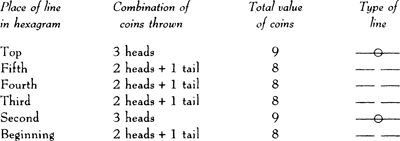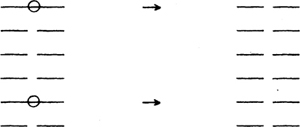
How to Consult the I Ching
What you will need
In addition to this book you will need pen, paper and three coins. If you can find them, use Chinese coins which are round with a square hole in the centre. These can sometimes be obtained from bookshops (two of which are detailed at the back of this book). But any three coins will do, provided they are of the same size and value. Before using the coins for the first time, you may like to wash them thoroughly, or soak them in salt water. This serves to purify and dedicate them for use with the I Ching. Keep them specially for this purpose, preferably in a box or wrapped up. Do not let other people handle them.
Making your preparations
Relax and allow your mind to become quiet. Then focus on the question you want to ask. Many people like to create a ritual to help them get into the right frame of mind. This can be something very simple like lighting a candle, settling into a comfortable position and taking a few slow, deep breaths.
Asking your question
If you want an understandable reply, you must ask a clear question. Avoid the either/or type of question. For example, ‘Would it be to my advantage to take the job with Smith and Co.?’ is a precise question. ‘Should I take the job with Smith and Co. or wait until I hear from Jones Ltd?’ would be too muddled. Alternatively, you can ask the I Ching to give you its views on a situation – ‘Would you please comment on the difficulties I am having with Jane’, for example. The answer will indicate the most constructive way to deal with the matter.
Making the hexagram
Shake the coins in your cupped hand and let them fall on to a flat, uncluttered surface. Traditionally, heads has the value of three and tails counts as two. If you have Chinese coins, the side inscribed with figures counts as two and the reverse side as three.
You will receive one of four possible combinations, each of which is then represented by a broken or unbroken line, as follows:

Write down whichever of these lines you have received. It now becomes the bottom or beginning line of your hexagram. Keeping your question in mind, repeat this process five more times. Add the lines one on top of the other until you have built up a hexagram or figure of six lines.
Example

Identifying your hexagram
Now you are ready to find out which hexagram you have drawn. The lower three lines are called the ‘lower trigram’. The top three lines form the ‘upper trigram’. In the example above,
![]()
Ignoring the markings ‘O’ and ‘X’ (think of these lines for now simply as broken (— —) or unbroken (———), turn to the Chart at the back of the book. Look at the row of trigrams going across the top (each described by a Chinese name) and find the one that corresponds with the upper trigram in our hexagram. Now look in the vertical row of trigrams down the left-hand side of the chart and identify the one which looks like the lower trigram. The box where they intersect contains the number of the hexagram we have made. You will find that it is number 4 which is called INEXPERIENCE. Interestingly enough, before writing this section, I asked the I Ching for a demonstration hexagram to help people to learn how it works. It came up with – INEXPERIENCE!
The moving lines
You will notice that the second and top lines in our practice hexagram are marked with a circle. This indicates that they are ‘moving lines’, so-called because they change into their opposites. The solid ——— changes into a broken — —. When a hexagram contains moving lines, the next step is to change these into the opposite type and construct a new hexagram. Here is what happens in the case of our example above:

Follow the instructions above to identify the new hexagram. You will find that it is number 2 which is called RESPONSIVENESS. I would take this to indicate that the more responsive you are to this new system, the more successfully you will learn. If you look at the section ‘Making the hexagram’ you will see that there is another type of moving line, the one which has the value of 6 —X—. When this appears in a hexagram, you must change it into its opposite, ——— and construct a new hexagram as above.
Only lines with the value of 6 or 9 – three tails or three heads – are moving lines and therefore subject to change. Lines with the value of 7 or 8 stay as they are in both hexagrams. The second hexagram will contain no moving lines.
If all the lines in your hexagram have the value of 7 or 8 then there are no moving lines. In this case, you will have just the one hexagram to study. It means that no immediate changes are on the cards. For the moment, the situation is fairly static.
Reading the hexagrams
1. The first hexagram comments on the current situation which is discussed in the first two sections of the text. If you have received only one hexagram, do not read any further.
2. If you have received moving lines, move to the third section, ‘Further aspects of the situation’ and read the text for your particular moving lines. It gives additional information about changes which may be in the air. In our example the relevant further aspects would be ‘Nine in the second place’ and ‘Nine at the top’.
3. Then look up the second hexagram. This tells you about future possibilities once the changes have taken place. Again read the first two sections of the text but this time do NOT consult the third section. Remember, this deals with moving lines only.
Do not be disheartened because this process sounds complicated. Just follow the instructions step by step, be patient and practise. Once you have consulted the I Ching a few times, you will understand just how easy it is to make a hexagram. In no time at all you will be rewarded for your patience in learning this procedure. The I Ching will rapidly become an invaluable source of advice which will help your life to flow in the best possible way.
Some do’s and don’ts
* DO approach the I Ching with respect, as you might a wise friend.
* DO ask your question with an open mind. If the answer you get is not the one you wanted to hear, remember that the I Ching is concerned with helping you to do the right thing. It has no interest in propping up your ego!
* DO consider keeping a special notebook for recording your questions and answers. This will help you to develop your friendship with the I Ching over time.
* DON’T ask your question when you feel distracted by other things. The I Ching tends to respond to whatever is most on your mind at the time. Unless you have cleared your mind of distractions, it may well comment on those rather than on the question itself.
* DON’T use the I Ching as a party game. Its purpose is to give you guidance when you have choices to make. If you just ask it silly questions, it will give you nonsensical answers.
* DON’T keep asking the same question over and over again. If you do, you will be quite likely to receive hexagram number 4 (INEXPERIENCE) which is the I Ching’s way of rapping you over the knuckles! The only exception to this is where you are involved in a situation which is static. In this case, you may want to ask from time to time if there are any changes in the air.